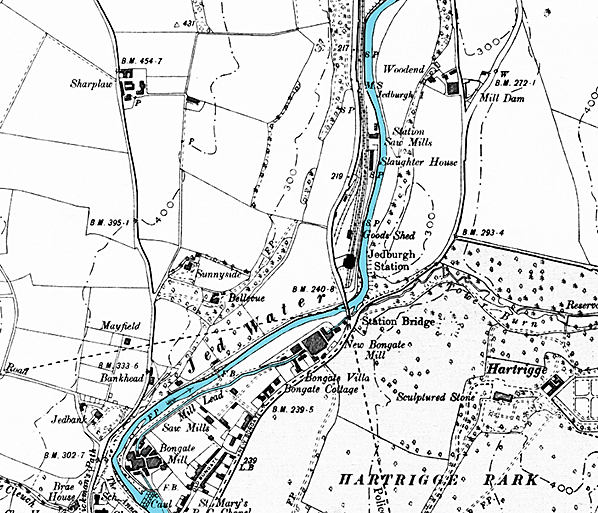
BRIEF HISTORY OF THE TWEEDMOUTH-KELSO-ST BOSWELLS LINE This 23½-mile route connected Tweedmouth on the East Coast main line with St Boswells on the Waverley Route, the former North British Railway’s main line between Carlisle and Edinburgh. It followed the broad valley of the River Tweed through the rich farmlands known as the Merse. At Coldstream it met the line to Wooler and Alnwick, and at Roxburgh a branch left for Jedburgh. PLANS FOR LINES TO KELSO The Caledonian Railway was determined to invade North British (NB) Railway territory and in 1845 proposed the Caledonian Extension Railway, 104 miles in length from Ayr to Berwick passing through Melrose and Kelso en route; the project failed to materialise, and the ‘Caley’ had to be content with Peebles as the limit of its penetration into the area dominated by the NB.
The Newcastle & Berwick (N&B) Railway Act of 31 July 1845 empowered this company to connect these places by what came to be known as the East Coast main line, with branches to Blyth, Alnwick and Kelso. The first part of the main line opened from a junction with its existing Newcastle–North Shields line at Heaton as far as Morpeth on 1 March 1847; Chathill–Tweedmouth opened on 29 March, followed by Morpeth–Chathill on 1 July 1847. On 29 August 1848 trains began operating across the River Tweed between Tweedmouth and Berwick over a temporary bridge, exactly two years before the permanent Royal Border Bridge was opened for passenger services. The Newcastle & Berwick amalgamated in August 1847 with the York & Newcastle to become the York, Newcastle & Berwick Railway (YNB). The Kelso Branch connected with the main line at Tweedmouth, about a mile south of Berwick, with a south-facing junction. OPENING OF THE TWO BRANCHES TO KELSO
When the NER and NB became linked at Kelso this route was the first to provide access from the south to the central Borders. It was not until 1862 that the NB Waverley Route between Hawick and Carlisle opened to give another approach from England. On 31 July 1854 the North Eastern Railway was formed by the amalgamation of the YNB with four other companies. In November 1854 the NB decided to charge the NER £370 a year for the use of Kelso station.
The junction at Tweedmouth faced south, reflecting the line’s origins as an English company with interests south of the border; moreover, Berwick station had been provided in 1846 by the Edinburgh-based North British Railway. Berwick, rather than Tweedmouth, was the obvious destination for most travellers from the Tweed valley, and passenger trains operated between Kelso and Berwick, with the result that an inconvenient reversal of trains was required at Tweedmouth.
Additional stations between Tweedmouth and St Boswells were later opened at Wark by July 1859 and Twizell in August 1861. Wark station was renamed Sunilaws in August 1871 and Cornhill became Coldstream in October 1873. Thus Cornhill station, in England, was renamed after a settlement in Scotland; conversely the village of Carham is in England but its station was in Scotland.
DESCRIPTION OF THE ROUTE AND ITS STRUCTURES Grindon Burn (Newbiggin Dene): 6 segmental arches; 134yd long and 103ft high. River Till: 6 segmental arches; 133yd long and 89ft high. East Learmouth: 5 semicircular arches; 94yd long and 60ft high West Learmouth: 7 semicircular arches; 118yd long and 62ft high The contrasting shapes of the arches reflected the difference in style preferred by the two contractors.
Each of the stations had two side-platforms (plus a bay at Kelso). East of Kelso the stations were designed by the Newcastle architects John and Benjamin Green, who were responsible for a series of excellent station buildings between Newcastle and Tweedmouth. Having spent generously on these main line stations the Newcastle & Berwick was in a more economical mood where the Kelso branch was concerned; nevertheless, attractive structures were built at Cornhill (later Coldstream) and Sprouston with plainer buildings elsewhere. The construction of Sprouston and Cornhill, possibly also of Carham and Wark (later known as Sunilaws), was by Mr Sanderson of Amble whilst a Mr Armstrong built those at Velvet Hall and Norham. The buildings at the later Twizell station, initially a request stop, were of little architectural merit. Goods traffic was handled at all stations, as well as at West Ord and Learmouth sidings, with generous facilities at Norham and Coldstream, the latter station with an adjacent cattle mart. Coal traffic was handled at all stations except Twizell and Carham.
In addition to constructing housing for the stationmasters the NER provided cottages for other employees. In 1898 a cottage was built at Ord for the pumping engineman, to which a further dwelling was attached in 1912. Close to the railway bridge at Velvet Hall three cottages were built, two probably in the mid nineteenth century and another in 1899. A pair of cottages was provided west of Twizell station. At Coldstream station two terraced blocks were built. The more easterly trio was built around 1882/83; the other four were constructed in 1897, and local magistrates prosecuted the NER for having built them without local authority approval. A pair of stone-built two-storey cottages was constructed at Green Lane Crossing, Coldstream, and at Learmouth Siding. Those at Learmouth (now demolished) were without mains water, and a supply was usually delivered by an up goods. At Sprouston there were six stone houses, probably built in the 1860s, and three of brick, apparently in 1900-02; none of these survive. In addition to the stations there were several sidings served by the Berwick – Kelso – St Boswells line. A public delivery siding was located at West Ord, originally on the down side but replaced with one on the up side in the 1930s. A private siding and depot were provided at Learmouth, midway between Coldstream and Sunilaws. This had a signal cabin but it was replaced with a ground frame in 1907 alongside the up line, moved to the opposite side of the tracks and enclosed in a wooden structure in 1912.
Carham (Shidlaw) Tile Works, ¾-mile east of the station, had rail connection to the up line, controlled by a ground frame. When the works closed the siding was retained for private farm use until 18 August 1930. Heiton Siding, between Kelso and Roxburgh, was provided from the opening of the line, on the down side. It comprised two sidings and was provided for the needs of local farms in the absence of a road crossing over the River Teviot to Roxburgh station. The facility closed on 23 March 1964. Charlesfield Depot was served by a branch from the Kelso – St Boswells line between Maxton and Kelso Junction at St Boswells. This was a World War 2 munitions factory that stretched over 168 acres and operated from 1942 until 1945, and it passed to the Royal Navy in 1949 to serve as an armaments depot. In December 1963 West Cumberland Farmers purchased the site from the Ministry of Defence. The depot railway system comprised 5,090yd of single track and a short loop was reinstated on the singled ‘main line’ to handle Charlesfield trains. Charlesfield Halt was provided on the Waverley Route to serve the depot.
TRAIN SERVICES When both companies became part of the London & North Eastern Railway at the ‘big four’ Grouping of 1923, and inter-company rivalry could no longer provide an excuse for it, the ‘two branch’ arrangement persisted as far as advertised services were concerned. A similar anomaly was found on London, Midland & Scottish territory between Burnley and Skipton where the pre-grouping frontier at Colne continued to be operated as such after 1923.
The NER worked passenger its services with BTP ‘A’ and ‘O’ class tank locomotives stabled at Tweedmouth shed. ‘C’ and ‘P’ class 0-6-0 tender engines hauled the goods services. Locomotive sheds were also provided at Kelso, Berwick (North British: closed by 1924) and Sprouston (closed 1916). A second route was available between Berwick and St Boswells, via Duns. This was the Berwickshire Railway, a somewhat longer route of 42 miles as against 35 via Kelso, which opened on 20 October 1865. The Berwickshire company was absorbed by the North British in 1876. Although a longer route, this one had the advantage of several through trains each day between Berwick and St Boswells whilst passengers on the more southerly line, as noted earlier, had to change at Kelso, usually with a long wait for the train to continue their journey, and endure the delay of a reversal at Tweedmouth.
Under LNER control loco workings on the Berwick-St Boswells circle of routes via Kelso and Duns were integrated, using engines from four local sheds (Tweedmouth, Jedburgh, St Boswells and Duns). Hoole (1978) notes, for instance, that in 1939 the St Boswells engine worked via Duns to Berwick, then Tweedmouth-Kelso-Berwick-Kelso-St Boswells. The Sentinel railcar Royal Charlotte which was stationed at Tweedmouth shed is understood to have been used for some LNER workings which, between 1932 and 1941 were indicated as ‘once class only’ in timetables. In about 1933 the LNER singled the track between Kelso and St Boswells – in passenger service terms the busier section of the line! Throughout Britain in the 1920s road motor transport began to offer serious competition to railway services, and the Kelso Branches were not immune. The Alnwick to Coldstream line – a late arrival and quiet in terms of passenger traffic – was seen off by road transport as early as 1930. A summer 1931 timetable indicates that Young’s Motor Service provided buses between Norham, Horncliffe, Ord and Berwick with five Monday-to-Friday trips between Norham and Berwick, six on Saturday and four on Sunday. On weekdays four further runs were provided between Horncliffe and Berwick. The same frequency operated in the opposite direction apart from there being only three Berwick – Horncliffe trips. In the mid 1930s a public transport map of the Borders area shows several bus services operated by United Automobile Services and the Scottish Motor Traction Company in the Berwick – Kelso corridor. The LNER timetables in the 1930s which indicated if omnibuses operated by companies associated with the LNER (in this case, United Automobile Services) served its stations; in winter 1937-38 Berwick, Tweedmouth, Velvet Hall, Coldstream and St Boswells are shown to be served.
By the late 1930s regular Sunday services ceased to operate on the line, although in the summer months from 1937 to 1939 a limited stop train conveying a buffet car ran through between Newcastle and Edinburgh. Travelling to Edinburgh its only calls on the Kelso route were at Tweedmouth (12.05pm), Norham (12.15), Coldstream (12.23), Kelso (a12.38, d12.39) and St Boswells (a1.04). Returning to Newcastle calls were at St Boswells (6.58), Kelso (a7.18, d7.20), Coldstream (7.34), Norham (7.42) and Tweedmouth (8.00). Sunday trains ceased altogether at the outbreak of World War 2. During the war the frequency of passenger trains was reduced on many lines, and three return passenger trains ran between Berwick and Kelso with a further morning return working between Berwick and Coldstream. On the singled section six weekday return trains (seven on Saturday) were provided. There were no Sunday trains.
In the last two decades of the Berwick – Kelso – St Boswells line through running of trains became the norm, plus short workings between Kelso and St Boswells, but some of the trains made remarkably long stops at Kelso. In the summer 1953 timetable the ‘limited stop’ train departing from St Boswells at 6.22am was fast through Maxton, Rutherford and Roxburgh arriving at Kelso at 6.41am, departing 54 minutes later at 7.35am. Passengers on the 8.33am from St Boswells had to put up with a 34-minute wait at Kelso (only 21 minutes on Saturday). Trains in the opposite direction spent less time at Kelso. So leisurely was the progress of trains on this line that the 35-mile journey could take up to 2hr 10min. As Mullay points out, ‘it was the familiar story of a poorly-timed, grudgingly-offered rural train service receiving precisely the public reaction it deserved’. Even well into British Railways’ days the North Eastern Region winter 1963-64 passenger timetable still showed only the Berwick-Kelso service (with a note that trains operated to and from St Boswells) whilst the Scottish volume generously included the entire Berwick-Kelso-St Boswells line. THE BRITISH RAILWAYS ERA: DECLINE AND CLOSURE
From 13 August 1948 the local passenger train service over the recently singled track between Kelso and St Boswells was suspended to provide paths for the diverted services; the Jedburgh Branch lost its passenger trains too, but these were never to be restored. The floods affected the Berwick- St Boswells via Duns route to the extent that passenger services were suspended between Duns and St Boswells, and were never resumed, and the line east of Duns was closed to passengers in September 1951. The summer 1953 timetable shows four through return workings between Berwick and St Boswells on weekdays with an extra return between Kelso and St Boswells. However, passenger traffic in British Railways years was light and dwindling. From 7 December 1953 Twizell station was unstaffed. British Railways proposed to save £7,744 a year by closing Velvet Hall, Twizell, Sunilaws, Sprouston and Carham stations, all on the former NER section, and substantially reducing the number of trains. In 1951 Velvet Hall issued only 176 tickets and Twizell, 537; even stations not proposed for closure were hardly busy, with 701 bookings at Norham and 1,366 at Coldstream. The 1951 Census gave Norham’s population as 639 and Coldstream’s as 1,287; the population of Cornhill, the location of Coldstream station, was 478. It was reported that annual revenue from Sunilaws amounted to £217, Velvet Hall £125, and Twizell £66 and in an October census the number of passengers travelling daily were four, six and two respectively. The withdrawal of all trains running between St Boswells and Berwick was considered but because of the substantial quantity of parcels traffic, consisting mainly of fresh meat, game and poultry, it was decided not to effect a complete closure. On 4 July 1955 Velvet Hall, Twizell, Sunilaws, Carham and Sprouston were closed to passengers and the frequency of trains was reduced. Between Berwick and Kelso there were now only two train journeys in each direction as shown in the timetable commencing 19 September 1955, departing from Berwick at 9.58am and 6.47pm and from Kelso at 8.50am and 4.40pm on weekdays (and, as before, no Sunday service). On 28 August 1956 the Kelso route once more proved its value as a diversionary route when the non-stop Elizabethan (Edinburgh Waverley – Kings Cross) was unable to use the ECML owing to flooding.
From 2 November 1959 Rutherford was unstaffed. By winter 1962-63 only two weekday services worked from St Boswells (dep 8.25am and 4.02pm) to Berwick with return workings at 9.56am and 6.35pm. A seven-minute turnaround was allowed at Tweedmouth. Two further St Boswells-Kelso return workings were shown. By this date most rural services in Britain had been taken over by diesel multiple units, but a steam locomotive and single coach were considered adequate for Berwick-St Boswells. One through diesel service is shown in winter 1960-61 timetable from Edinburgh to Kelso. Passenger traffic was supplemented by goods, principally cereals and potatoes outwards and coal, lime, fodder and livestock inwards. Norham also dispatched milk churns, cases of eggs and boxes of wild rabbits in passenger trains. The sidings at West Ord, Learmouth and Heiton contributed a small amount of goods traffic. The Berwick-St Boswells line was included in the Reshaping of British Railways (‘Beeching Report’) of March 1963 as one already under consideration for closure, and Tweedmouth station was included. Although Tweedmouth was among the largest population centres on the main line in Northumberland (approximately 4,000) Berwick eclipsed it in importance. In 1951 only 1,957 tickets were issued at Tweedmouth. By summer 1960 one local ‘main line’ passenger train in each direction called at Tweedmouth on weekdays, the poorest service of any Newcastle–Berwick station. With an average of only six passengers per train, the operating cost for passenger trains on the Berwick-St Boswells line was reportedly £58,920 per annum against receipts of only £2,260, and in 1962 the decision had been made to close it to passengers.
In Railway Magazine (April 1964) it is reported that the Minister of Transport, Ernest Marples, had consented to the closure of the Berwick – St Boswells route subject to the provision of an additional bus service twice daily each way between Kelso and St Boswells via the isolated stations at Roxburgh, Rutherford and Maxton, also that prior notification must be given of any proposal to take up the track.
The line and some stations remained open for goods traffic, but Tweedmouth-Kelso closed entirely on 29 March 1965 and Kelso to St Boswells on 30 March 1968. The down line was lifted in 1966 by Campbell’s of Airdrie and Carham and Coldstream stations’ buildings were demolished soon after. The up line was removed in 1969/70 soon to be followed by the steel and cast iron bridges.
THE JEDBURGH BRANCH
Passenger services on the Jedburgh Branch survived until August 1948, the first year of nationalisation. Unusually heavy rainfall on 12 August, following several rainy days, resulted in damage to the East Coast main line north of Berwick and the diversion of expresses via Kelso. The Jedburgh Branch was washed out between Nisbet and Jedfoot resulting in the suspension of train services. Within a week goods services resumed, but the occupation of the Berwick – Kelso – St Boswells line (singled between Kelso and St Boswells) by diverted expresses provided an opportunity not to restore the passenger service and in May 1949 the withdrawal of branch passenger trains was made permanent. The decline in passenger traffic could also be used to justify closure as illustrated by Jedburgh’s bookings falling from 37,000 in 1913 to 23,000 in 1923 and 15,000 in 1932, whilst goods traffic remained buoyant. Goods traffic continued at all of the Jedburgh Branch stations until 10 August 1964 when the line closed completely.
FINAL BRITISH RAILWAYS SERVICE IN THE BORDERS – IN 1998-99 Maps: Ordnance Survey 1:10,560 (6" to 1 mile 1896 - 1899. Closure notice from Roy Lambeth collection. Bradshaws from Nick Catford. The author is grateful to Darren Kitson for his generous assistance with information for photograph captions. To see stations on the Tweedmouth - St Boswells line click on the station name (stations not yet linked are coming soon): Tweedmouth, Velvet Hall,Norham, Twizell, Coldstream, Sunilaws, Carham, Sprouston, Kelso, Wallace Nick, Roxburgh, Rutherford, Maxton & St Boswells BIBLIOGRAPHY
 Home
Page Home
Page
|



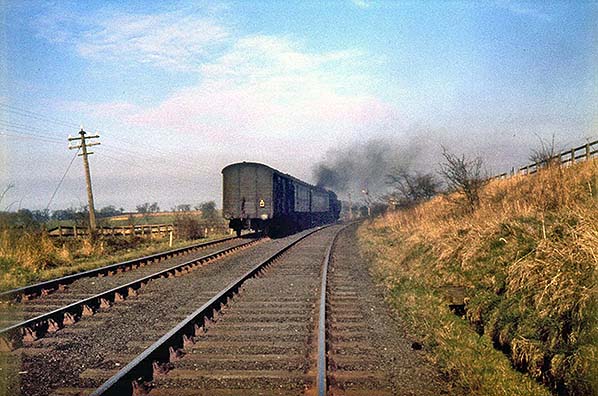 A local train bound for Berwick is approaching Norham station probably in winter 1963-64; by the standards of this line the two carriages and the van at the rear was lavish provision, as on many occasions in the later years one carriage was considered sufficient for the few passengers.
A local train bound for Berwick is approaching Norham station probably in winter 1963-64; by the standards of this line the two carriages and the van at the rear was lavish provision, as on many occasions in the later years one carriage was considered sufficient for the few passengers.

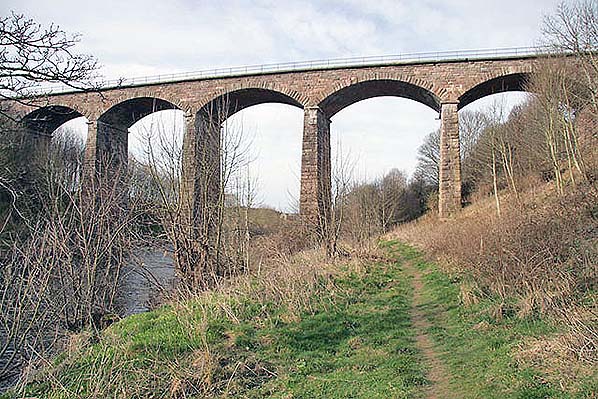 The impressive Twizell Viaduct spanning the River Till (a tributary of the River Tweed) south-west of Twizell station. It was built in 1849 and recently upgraded to allow public access thereby linking in with a network of public footpaths. The 6-arch viaduct, also known as St Cuthbert’s Viaduct, is a grade 2 listed structure under the care of BRB (Residuary) Ltd who are responsible for the remaining assets of the British Railways Board. Viewed from the public footpath to Twizell Boathouse.
The impressive Twizell Viaduct spanning the River Till (a tributary of the River Tweed) south-west of Twizell station. It was built in 1849 and recently upgraded to allow public access thereby linking in with a network of public footpaths. The 6-arch viaduct, also known as St Cuthbert’s Viaduct, is a grade 2 listed structure under the care of BRB (Residuary) Ltd who are responsible for the remaining assets of the British Railways Board. Viewed from the public footpath to Twizell Boathouse.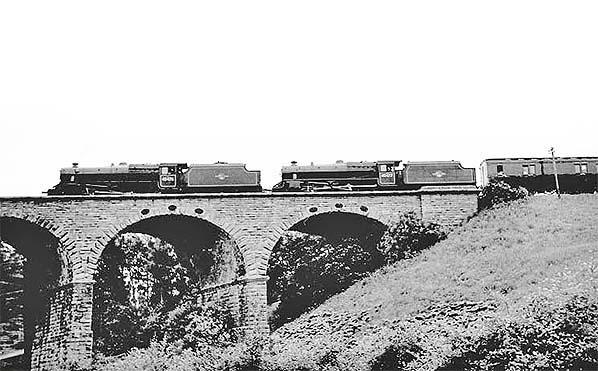 The empty stock of the Royal Train is crossing the viaduct over Duddo Burn at West Learmouth near Coldstream on 5 July 1962 behind 64C, Dalry Road shed, ‘Black 5s’ 45476 and 45477. The train is on its way from St Boswells to Coldstream to collect HM the Queen following a royal visit before returning to London via Tweedmouth and the East Coast main line.
The empty stock of the Royal Train is crossing the viaduct over Duddo Burn at West Learmouth near Coldstream on 5 July 1962 behind 64C, Dalry Road shed, ‘Black 5s’ 45476 and 45477. The train is on its way from St Boswells to Coldstream to collect HM the Queen following a royal visit before returning to London via Tweedmouth and the East Coast main line.
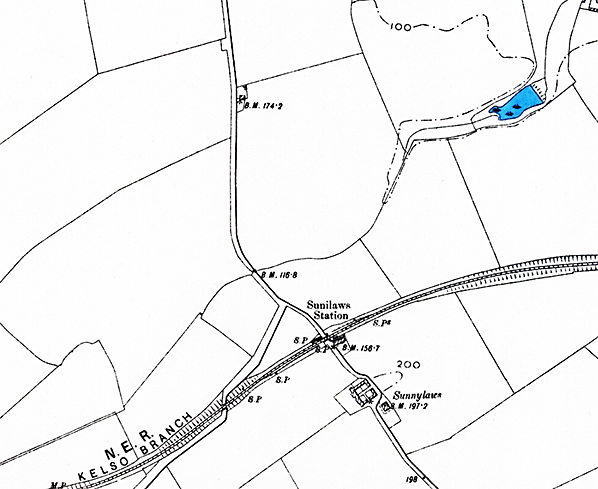
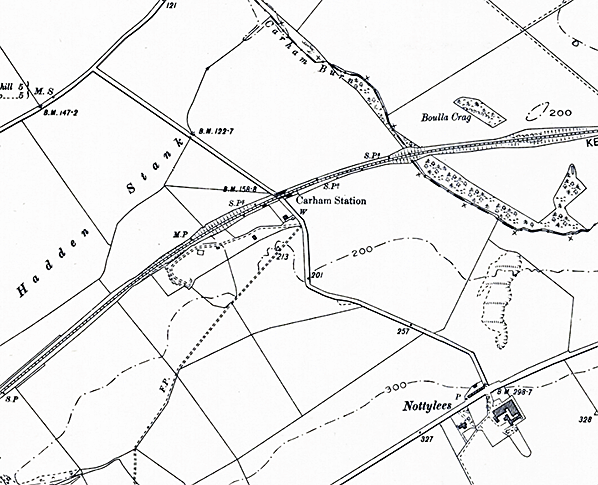
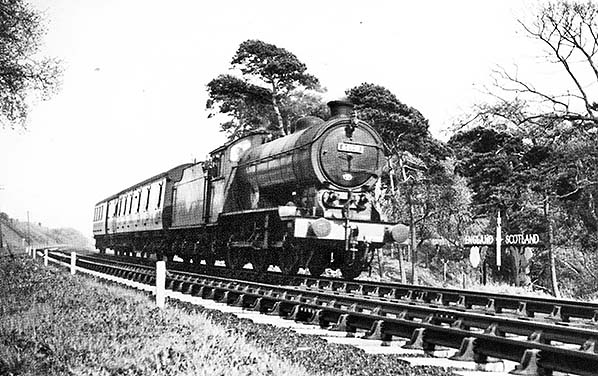 On 14 May 1955 Tweedmouth-based J39 0-6-0 No.64941 is crossing the Anglo-Scottish border near Carham with a Berwick-St Boswells service.
On 14 May 1955 Tweedmouth-based J39 0-6-0 No.64941 is crossing the Anglo-Scottish border near Carham with a Berwick-St Boswells service.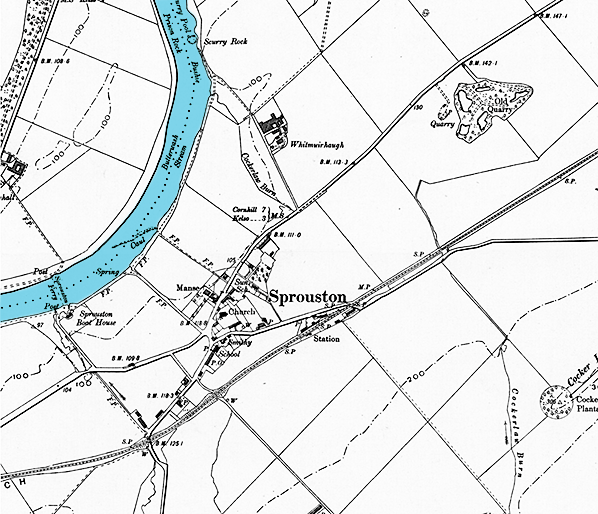
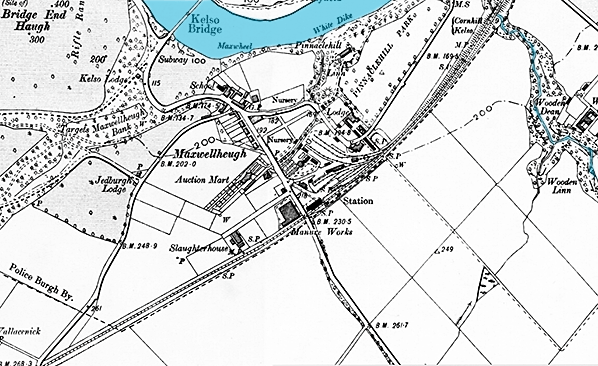

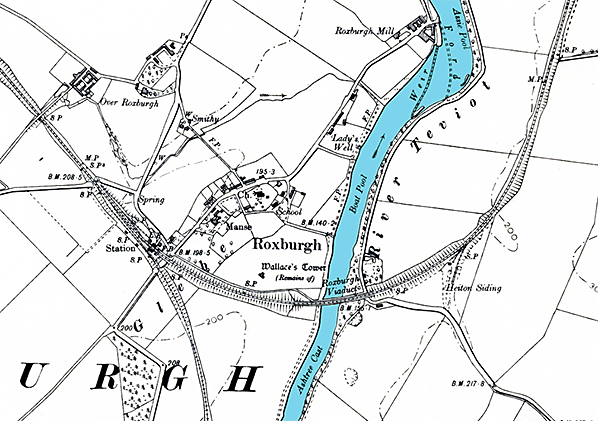
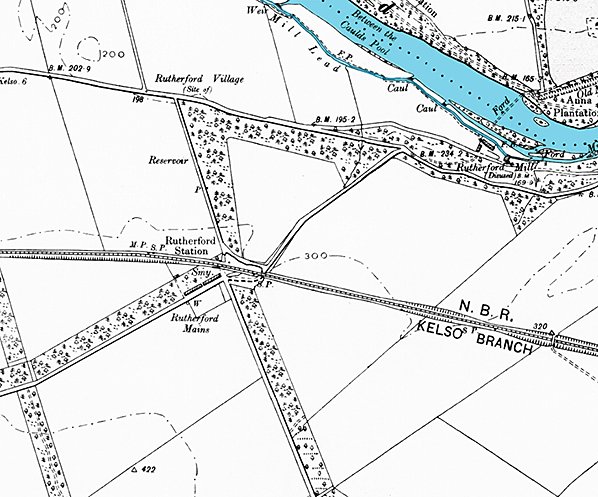
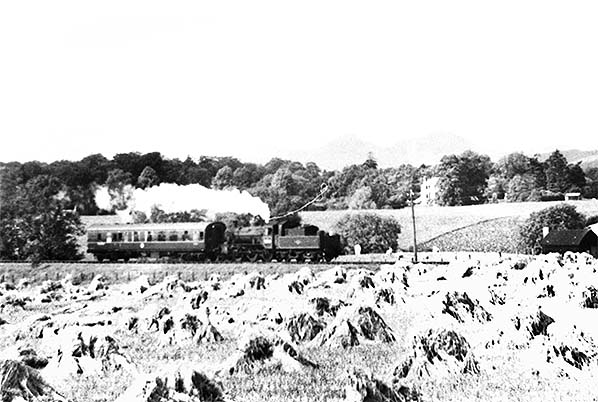 In September 1962 a Berwick-St Boswells single-coach train is headed by Standard 2-6-0 No.78049 between Kelso and Roxburgh.
In September 1962 a Berwick-St Boswells single-coach train is headed by Standard 2-6-0 No.78049 between Kelso and Roxburgh.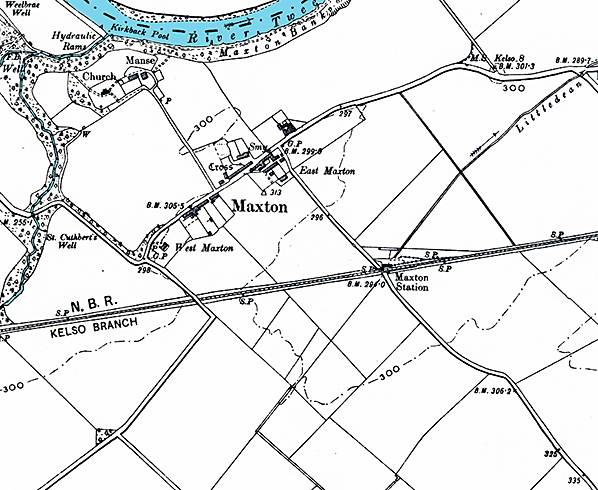
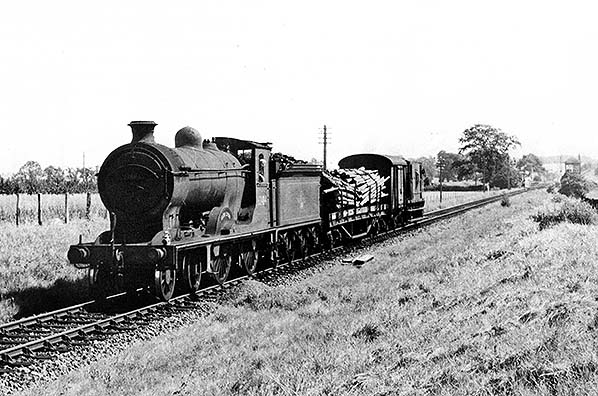 On 1 August 1961 'Glen' class 4-4-0 No.62484 'Glen Lyon' is on a freight working from Jedburgh to Galashiels and has just passed through Maxton station. The diminutive payload will be noted.
On 1 August 1961 'Glen' class 4-4-0 No.62484 'Glen Lyon' is on a freight working from Jedburgh to Galashiels and has just passed through Maxton station. The diminutive payload will be noted.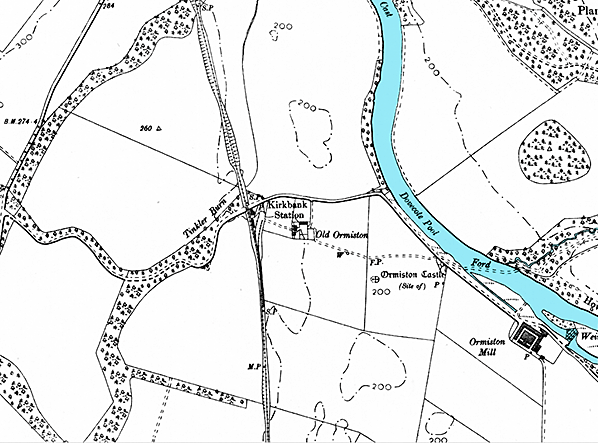
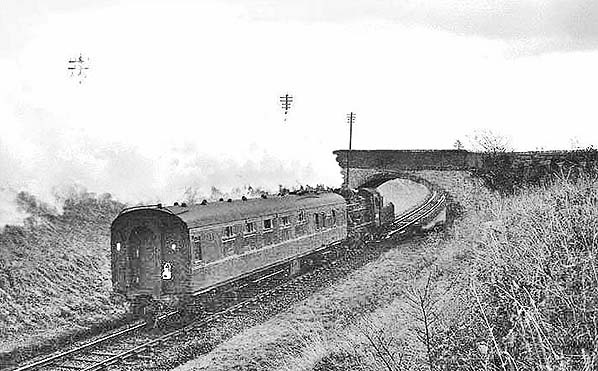 One of the Hawick shed's standard class 2 locomotives with the 11.24 am St. Boswells - Kelso train shortly after leaving Kelso Junction on 9 November 1963. The train is about to pass under the bridge carrying the A699 road.
One of the Hawick shed's standard class 2 locomotives with the 11.24 am St. Boswells - Kelso train shortly after leaving Kelso Junction on 9 November 1963. The train is about to pass under the bridge carrying the A699 road.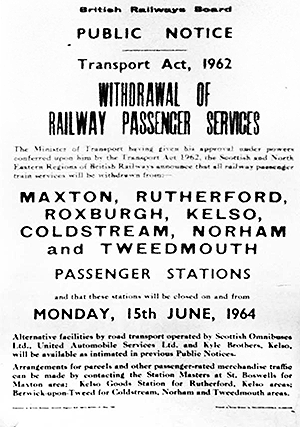 Closure took place on Monday 15 June 1964, the final trains having run two days earlier. The last train was headed by BR ‘2MT’ No.78048 and was dubbed Kelso Laddie by the local newspaper.
Closure took place on Monday 15 June 1964, the final trains having run two days earlier. The last train was headed by BR ‘2MT’ No.78048 and was dubbed Kelso Laddie by the local newspaper.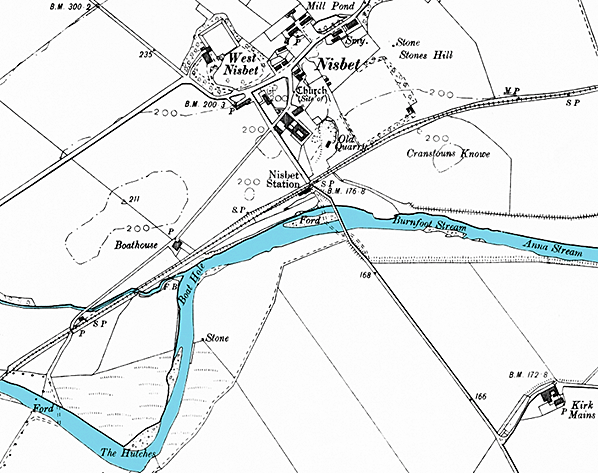
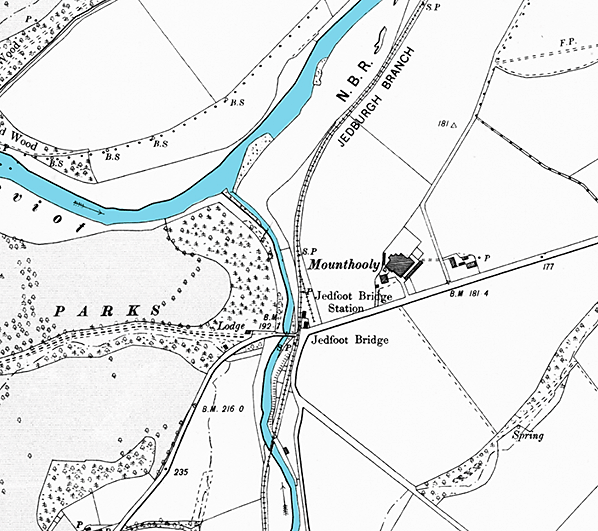
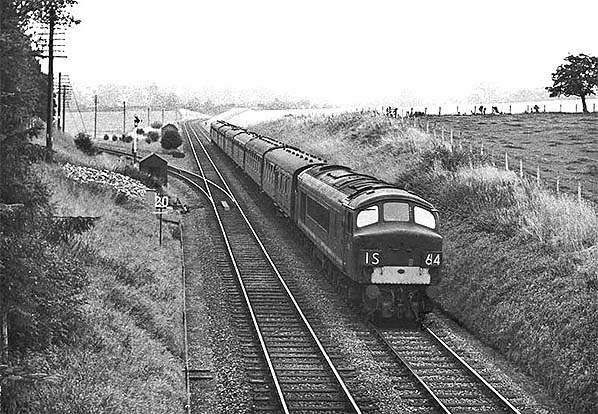 A Peak brings the down Waverley past Kelso Junction in the 1960s.
A Peak brings the down Waverley past Kelso Junction in the 1960s.
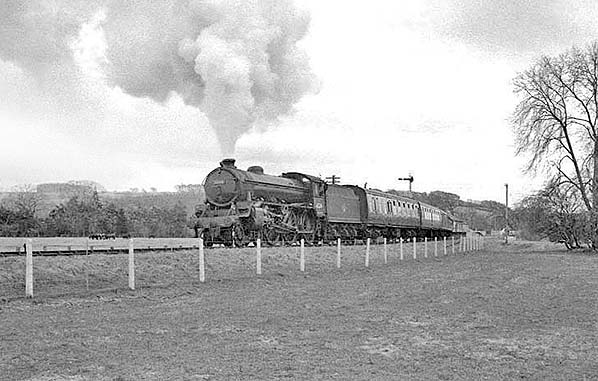 B1 No 61324 on its way back from Jedburgh in April 1963 with the SMS/BMS Scottish Rambler No 2 railtour which has just passed through Jedfoot station.
B1 No 61324 on its way back from Jedburgh in April 1963 with the SMS/BMS Scottish Rambler No 2 railtour which has just passed through Jedfoot station.